Post by Kip Deeds
Bucks County is known for its association with Pennsylvania Impressionism, a movement in which artists like Daniel Garber and Edward Redfield made paintings like the French. It has been difficult to see alternatives to this living tradition in part because history and lore have been intertwined. There are also few institutional venues in Bucks County that look to advance the art of the region in ways that reach beyond a connection to this recent past. The art gallery at Bucks County Community College is one of the few venues where this can happen. Diverse faculty members often work closely with the gallery director Fran Orlando to organize exhibits. Caren Friedman, the college’s printmaking professor, for example, curated the current show “Imprint/Impact.”
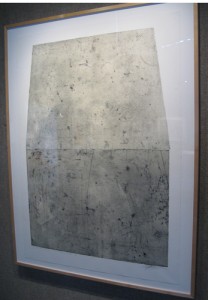
The exhibit features Gail Deery, Tony Rosati, John Strawn, Shelley Thorstensen, and Sergei Tsvetkov. All of the artists have had local ties and I learned at the opening that Deery and Strawn attended the college years ago. Although Gail Deery’s installations are the most dimensional works in the exhibit, I began to believe that sculptural ideas about shape and form are what connect the work in this exhibit.
Shape and embossed divisions from large printing plates dominate Sergei Tsvetkov’s work. Fundamental decisions about shape are contrasted with etched marks that appear to be the result of chance related actions. Each print is comprised of two to three colors that appear to be skillfully and efficiently printed in a minimal number of passes through the press.
John Strawn creates shapes formed on printing plates using collagraphic techniques. The shapes become silhouettes of imagined figures and are printed in black. Close up, the figures appear raised on the surface of the paper. From a distance, these works read as one connected collection of figurative shadows.
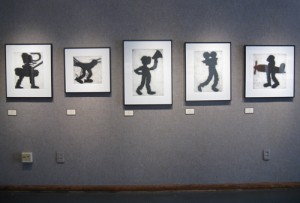
Gail Deery’s work seems to be combining many of Dieter Roth’s interests, notably his use of books and mold (Roth a Swiss-German artist spent some time in Philadelphia in the early 1960’s). In general, Deery’s work appears more orderly and contained than Roth’s whose work often appears on the verge of being out of control. In a large wall installation Deery presents books that are loosely spread open and attached to the wall. Impressions of mold in various greens appear on the pages. Although this installation elicits more questions than answers, it also provides a stirring and interactive presence in the gallery.
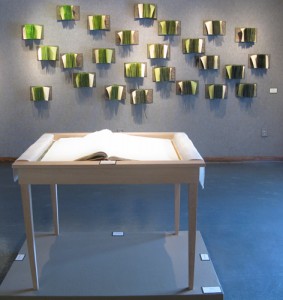
Deery’s other work involves a carefully constructed book and wood display. The pages are made of hand-fabricated paper and each page contains the same watermark. The watermark reveals subtle but pristine looking text. The text (quoted below) is ripe with irony (in a compelling way) given the careful construction and presentation of the book.
The Ailanthus
This tree is a native of China and is sometimes called the Chinese Sumach. It seems to have first been planted in America in 1820 on Long Island, and many of the trees planted early have reached a height of sixty or seventy feet and a trunk diameter of four or five feet. Its chief disadvantages for ornamental planting, in addition to that of vile-smelling blossoms, are its tendency to sucker and penetrate wells and cisterns with its roots which give the water a nauseating taste.
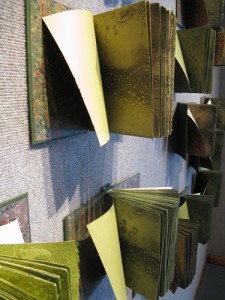
During the gallery talk opening night, I learned that Shelley Thorstensen often works on both sides of thin semitransparent paper to illicit subtle effects. This dimensional mode of working is one of a number of techniques that Thorstensen applies. Although Thorstensen’s work often alludes to forms found in nature, ultimately these works seem more about abstract relationships. After trying to decode the line work, I found myself being drawn inward to marvel at the formal and material subtleties found in her work. After a close appraisal, I realized that reproductions of her work couldn’t possibly do these prints justice.
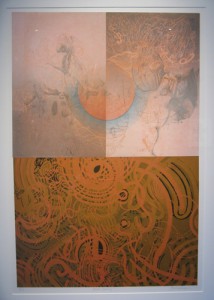
Rounding out the exhibit is a group of small mezzotints by Tony Rosati. Each print depicts a single egg in a unique environment. Like the central print in Sergei Tsvetkov installation, several of Rosati’s works are likewise printed from uniquely shaped plates. Although the titles of some of Rosati’s prints involve tongue in cheek humor, these works seem more about intimate meditation and careful attention.
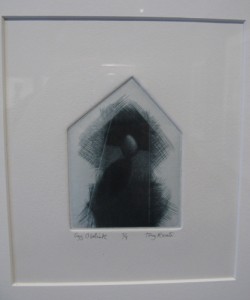
It was a joy to spend time with this exhibit, and it is a pleasure to have such a resource so close to my home. I only wish that this exhibit or others at the college, such as Don Colley’s drawing exhibit or Caitlin Perkins’ interactive installations were more accessible to a wider audience. Bucks County Community College is located in the bucolic suburbs on the site of Stella Elkins Tyler’s home (the one she moved to after leaving Elkins Park). In some respects, perhaps this relatively isolated gallery (a building in which the Tylers use to keep their cars) and the college’s art program are now more like the old Tyler School of Art than the new Tyler School of Art. I am not sure, but I am glad it is here.
Imprint/Impact at Bucks County Community College Gallery January 20 – March 9, 2010









